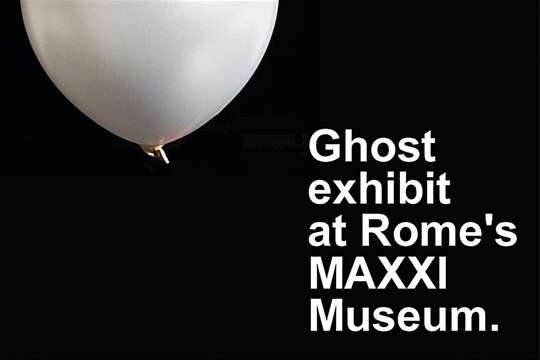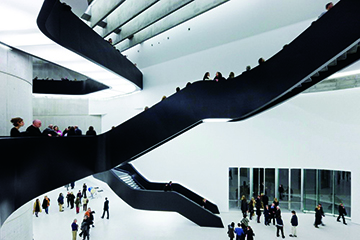TAKING SPECTERS SERIOUSLY
| January 17, 2014 | Post In LEAP 24

IT WAS IN the final days of preparation for our October issue that I received an email from a one Li Yuxin. Just having edited a heavy ream of articles on labor and the culture it may produce, I sighed and opened my inbox, only to see an announcement, sent by Li herself:
Hi, my name is Yuxin. I am an artist from Wenzhou (Zhejiang, China) who has lived in Rome since 2009.
This summer I was forced to abort during the third month of pregnancy.
In memory of my child, I created a piece in which I use the tiny body.
For the sake of brevity, I summarize the key facts behind this artwork, titled “Ghost Body”:
1. Chinese factory worker saves five years’ worth of salary to immigrate to Italy.
2. She arrives, only to find herself working in another Chinese factory.
3. She becomes pregnant, but her boss finds out, and forces an abortion.
4. Factory worker secretly places fetus inside an urn at the MAXXI museum in Rome.
5. Factory worker calls this art.
The October issue had me deeply mired in philosophical meanderings about the value of labor, about the position of China in the course of human history, and about the intercourse between art and reality. That being said, the idea to write about “Ghost Body” arose instantaneously. Furthermore, not hours before, LEAP editorial staff had engaged in a lengthy discussion with regards to the parameters of “Border Crossings,” a new column meant to investigate art made outside the boundaries of the System. Ms. Li had indeed traversed several boundaries. Could I possibly ignore her?
There are several options for exploring and interpreting “Ghost Body.”
One. A specter is haunting Europe! Li Yuxin and her story are real. This poor girl fought for years to escape the living conditions that China had granted her, only to be met with the same grim horror in the West. Capitalists are the same. She has effectively demonstrated the Marxist claim that borders do not exist between the bourgeois. To be employed at their hands, no matter where, is to be repressed. The class struggle is not dead; the fate of our progeny proves this. In this case, “Ghost Body” would be a powerful expression of humanity in the face of its many governors, be these economic, political, social, or the like. In its sadness and revulsion, it would be an action worthy of our empathy and rumination, a grotesque monument to suffering.
Two. China is an unstoppable beast, soulless and sans morals! Li Yuxin and her story are only partly real. She is a puppet and the rest is embellished. Within this mirage, the political slogan behind “Ghost Body” is very similar to above—the flow of capital is a merciless curse on humanity—but with a very different agenda: China bashing. Capitalism has long since taken control of the world, but its proudest flag is no longer red, white, and blue. As proven by an infatuation with a certain, portly artist, the ears of Western media are never more attuned than to a clash between art, human rights, and China. In this case, Li’s puppeteers would be riding a shameless bandwagon.
Three. Political farce! Li Yuxin is not at real, but the invention of some spiteful artist, conservative political party with Vatican ties, or just an obstreperous university student… In this case, we might imagine the perpetrator to be Italian, and “Ghost Body” to be an act of protest. Hou Hanru will assume the position of director of MAXXI at the end of this year, and one can imagine that in an economically downtrodden Italy there might be a disgruntled local xenophobe or two. To have a Chinese man oversee un museo nazionale italiano? Blasfemia! Should our perpetrator be looking to aggravate, the world’s most populous nation, again, offers plenty of sore spots. This third explanation is obviously not ideal, but neither, often, is life. The fact that it might even cross my mind in the first place is worth analysis. Does my imagination prove me a vile person? Have I in transmitting these malicious thoughts perverted the intentions of Li Yuxin? Perhaps “Ghost Body” is a true story, and I have tainted this innocent artist’s name…

There are, of course, other possible explanations for “Ghost Body.” In lieu of further postulation, we might instead ask a more important question, one that applies to any and answers: Why invoke art?
For a hundred years’ nigh, the span of art’s definition has broadened without cessation. The honor of aesthetic judgment used to be granted only to paintings and sculpture; now, we are forced to consider the value of everything from toilets and telegrams to beds and bowel movements. In this respect, Li Yuxin is well within her right as an artist to employ her unborn child in the creation of an artwork. (The strategy, however, puts the sincerity of the work into question. Chinese contemporary art is supposed to be above and beyond fetal antics. Perhaps Li Yuxin, as an unknown amateur artist still constrained by the shackles of her living situation, felt that a painting or a sculpture would not garner sufficient attention to her plight. It is difficult to say without knowing the artist. The only thing that can be said with certainty is that whoever is behind Li Yuxin, he/she/they perceive contemporary art as the ultimate embodiment of freedom, a safe resort for expression, and a viable counter to calamity. This is one of the few positive implications of “Ghost Body,” perhaps the only we should retain.
In the end, without knowing the truth behind “Ghost Body,” I might prefer that the name Li Yuxin never grace these pages, so as to avoid undeserved glorification. At the very least, this game of cat-and-mouse might be better suited to a detective novel than to a serious magazine of contemporary art. Shock art really isn’t our thing. Alas, it was Li Yuxin who cast the first stone. Who am I to resist its provocation? I implore the reader to treat this project with the same suspicion with which he or she considers much of contemporary art today.
And for those of you who go marching to MAXXI in search of the urn?3 Please do let us know what you find inside. I’m placing money on it being a brand-new copy of Das Kapital… and maybe a used ticket to a football match…
1. For his performance Eating People (2000), Zhu Yu cooked and ate a fetus. The entire process was documented and exhibited as part of the infamous AWW-curated exhibition “Fuck Off!” in Shanghai that same year.
2. The author of this article had originally intended to anonymously interview Li Yuxin, but out of caution thought better of it. To do so might be an act of complicity. In the words of Mark Zuckerberg’s sister: “I think anonymity on the Internet has to go away. People behave a lot better when they have their real names down.”
3. On a site-specific search of the MAXXI collection, the word “urn” only turns up in relation to one object: Carlo Scarpa’s Tomba della famiglia Capovilla, cimitero di San Michele in Isola, Venezia [The Capovilla Family Grave, San Michele in Isola cemetery, Venice]. It appears to be an architect’s draft.

